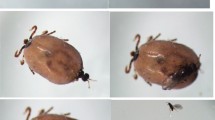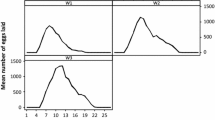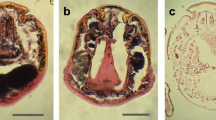Abstract
In some studies the prevalence of tick infection (infection rate) and the intensity of infection are negatively correlated with unfed tick age (in the broad sense of this term). However, no special research has been carried out to consider the phenomenon thoroughly. The infection indices of the female taiga ticks, Ixodes persulcatus, infected with Borrelia burgdorferi s.l. were related to tick physiological age, an index that more precisely reflects tick physiological state than the time of tick collection in the field or the duration of tick survival under laboratory conditions. A novel quantitative technique of physiological age determination based on the evaluation of the ratios between sizes of the stable (scutum) and the changing (alloscutum) structures of the tick body was used. The age was estimated in accordance with the classical age-grade scale introduced by Balashov and a more fractional scale determined by the new technique. In total, 131 female ticks were examined for their infection and physiological age, 46 of which were infected with B. burgdorferi s.l. (mean infection rate 35.1%). The minimal intensity of infection was 0.4 bacterial cells per 100 fields of view whereas the maximal infection was 172 cells. There was no difference between the prevalence of infection in ticks of different physiological age. The intensity of infection obviously differed between ticks of different age groups in the scale introduced by Balashov but did not significantly differ between ticks of different age groups according to the fractional age-grade scale. The data concerning the relationships between Borrelia burgdorferi and unfed Ixodes ticks are considered.
Similar content being viewed by others
References
A.N. Alekseev L.A. Burenkova I.S. Vasilyeva E.V. Dubinina S.P. Chunikhin (1996) ArticleTitleThe functioning of mixed tick-borne infection foci over Russia Med. Parazitol. Parazit. Bolezni 4 9–16
Balashov Y.S. 1961. Dynamics of stored nutritional substances and age determination in unfed ixodid ticks. Zool. Zh. 40: 1354–1363 (in Russian) (English translation: NAMRU-3 T117).
Y.S. Balashov (1962) ArticleTitleDetermination of the physiological age and age composition of unfed female Ixodes ricinus and Ixodes persulcatus in the Leningrad Region Med. Parazitol. Parazit. Bolezni 31 47–55
Y.S. Balashov (1972) ArticleTitleBloodsucking ticks (Ixodoidea), vectors of human and animal diseases Misc. Publ. Entomol. Soc. Am. 8 159–376
Y.S. Balashov (1995) ArticleTitleRelationships between ixodid ticks (Ixodidae) and agents of arthropod-transmitted infections of vertebrates Parazitologiya 29 337–352
Balashov Y.S. 1998. Ixodid ticks – parasites and vectors of diseases. “Nauka”, St. Petersburg (in Russian).
W. Burgdorfer S.F. Hayes D. Corwin (1989) ArticleTitlePathophysiology of the Lyme disease spirocheteBorrelia burgdorferiin ixodid ticks Rev. Infect. Dis. 11 IssueIDSuppl. 6 S1442–S1450 Occurrence Handle2682956
R.J. Dalgliesh N.P. Stewart (1979) ArticleTitleObservations on the morphology and infectivity for cattle of Babesia bovis parasites in unfed Boophilus microplus larvae after incubation at various temperatures Int. J. Parasitol. 9 115–120
R.C. Falco D. Fish J. Piesman (1996) ArticleTitleDuration of tick bites in a Lyme disease-endemic area Am. J. Epidemiol. 143 187–192 Occurrence Handle1:STN:280:BymC3sfjtlU%3D Occurrence Handle8546120
K.T. Friedhoff (1990) ArticleTitleInteraction between parasites and tick vector Int. J. Parasitol. 20 525–535 Occurrence Handle1:STN:280:By6D3cfgvVU%3D Occurrence Handle2120142
K.T. Friedhoff R.D. Smith (1981) Transmission of Babesia by ticks M. Ristic J.P. Kreier (Eds) Babesiosis Academic Press New York 267–321
H. Hurd (2003) ArticleTitleManipulation of medically important insect vectors by their parasites Annu. Rev. Entomol. 48 141–161 Occurrence Handle10.1146/annurev.ento.48.091801.112722 Occurrence Handle1:CAS:528:DC%2BD3sXnvVymug%3D%3D Occurrence Handle12414739
E.I. Korenberg (1996) ArticleTitleTaxonomy, phylogenetic interrelations and areas of form-forming in spirochetes of the genus Borrelia transmitted by ixodid ticks Uspekhi Sovremen. Biol. 116 389–406
E.I. Korenberg N.B. Gorelova Y.V. Kovalevskii (2002) Ecology of Borrelia burgdorferi sensu lato in Russia J. Gray O. Kahl R.S. Lane G. Stanek (Eds) Lyme Borreliosis: Biology, Epidemiology and Control CAB International Oxford 175–200
Y.V. Kovalevskii E.I. Korenberg S.V. Dauiotas (1990) ArticleTitleAssessment of various methods of making vital preparations for detection of borreliae in ixodid ticks Med. Parazitol. Parazit. Bolezni 1 33–35
Y.V. Kovalevskii E.I. Korenberg I.G. Nikitochkin (1991) ArticleTitleOptimization of the method for estimating the incidence rate and degree of tick individual infection with Borrelia Med. Parazitol. Parazit. Bolezni 3 18–21
Kovalevskii Y.V., Korenberg E.I. and Levin M.L. 1993. Seasonal and annual variation in the rate of infection by the Lyme disease pathogen in Ixodes persulcatus and I. ricinus ticks. In: Korenberg E.I. Problems of Tick-Borne Borrelioses. Moscow, pp. 147–156.
N. Lebet L. Gern (1994) ArticleTitleHistological examination of Borrelia burgdorferi infections in unfed Ixodes ricinus nymphs Exp. Appl. Acarol. 18 177–183
H. Lefcort L.A. Durden (1996) ArticleTitleThe effect of infection with Lyme disease spirochetes (Borrelia burgdorferi) on the phototaxis, activity, and questing height of the tick vector Ixodes scapularis Parasitology 113 97–103 Occurrence Handle8760310
H.M. Martin S.F. Barnett B.O. Vidler (1964) ArticleTitleCyclic development and longevity of Theileria parva in the tick Rhipicephalus appendiculatus Exp. Parasitol. 15 527–555 Occurrence Handle10.1016/0014-4894(64)90045-1 Occurrence Handle1:STN:280:CCqD2cnmvFI%3D Occurrence Handle14242265
W.D. McEnroe (1974a) ArticleTitleSize variation in the adult American dog tick, Dermacentor variabilis Say (Acarina: Ixodidae) Acarologia 16 214–219 Occurrence Handle1:STN:280:CSmD3Mrns1E%3D
McEnroe W.D. 1974b. Spread and variations of populations in Eastern Massachusetts of the American dog tick. Massachusetts Agricultural Experiment Station, Research Bulletin No. 603.
G.G. Moskvitina E.I. Korenberg L.Y. Gorban’ (1995a) ArticleTitleThe presence of borreliae in the midgut and salivary glands of spontaneously infected adult Ixodes persulcatus Schulze ticks during bloodsucking Med. Parazitol. Parasit. Bolezni 3 16–20
G.G. Moskvitina E.I. Korenberg A. Spielman T.V. Shchyogoleva (1995b) ArticleTitleOn frequencies of generalized infection in unfed adult ticks of the genus Ixodes in Russian and American foci of borrelioses Parazitologiya 29 353–360 Occurrence Handle1:STN:280:BymD1MfntFU%3D
G.G. Moskvitina E.I. Korenberg V.V. Nefedova Y.V. Kovalevskii N.B. Gorelova (2002) The dynamics of borrelia content in spontaneously infected unfed adult taiga ticks E.I. Korenberg N.A. Zabrodin (Eds) Kleshchevye Borreliozy Materialy Naychno-Prakticheskoi Konferentsii. Izhtekhnoservis Ltd. Izhevsk 205–207
U.G. Munderloh T.J. Kurtti (1995) ArticleTitleCellular and molecular interrelationships between ticks and prokaryotic tick-borne pathogens Annu. Rev. Entomol. 40 221–243 Occurrence Handle10.1146/annurev.en.40.010195.001253 Occurrence Handle1:CAS:528:DyaK2MXjtVWltrs%3D Occurrence Handle7810987
M. Nakao (1995) ArticleTitleIxodes persulcatus and Lyme disease spirochete: comparison of development between infected and noninfected ticks Jpn. J. Sanit. Zool. 46 241–247
R.L. Naumov (1999) ArticleTitleThe questing activity of the taiga tick Ixodes persulcatus infected with borreliae Parazitologiya 33 251–256 Occurrence Handle1:STN:280:DC%2BD3c3jsValug%3D%3D
R.L. Naumov (2003) ArticleTitleThe longevity of the sheep and taiga ticks (Ixodidae) infected and uninfected with borreliae of the burgdorferi group Parazitologiya 37 527–532 Occurrence Handle1:STN:280:DC%2BD2c%2FnsFyksg%3D%3D
R.L. Naumov I.S. Vasilyeva V.P. Gutova A.S. Ershova (1998) ArticleTitleAmplification of Lyme disease pathogen, Borrelia burgdorferi s.l., in Ixodes persulcatus ticks Parazitologiya 32 412–421 Occurrence Handle1:STN:280:DyaK1M%2Fns1ahsQ%3D%3D
J. Piesman (1995) ArticleTitleDispersal of the Lyme disease spirochete Borrelia burgdorferi to the salivary glands of feeding nymphal Ixodes scapularis (Acari: Ixodidae) J. Med. Entomol. 32 519–521 Occurrence Handle1:STN:280:ByqA2sbgsFc%3D Occurrence Handle7650714
J. Piesman A. Spielman (1980) ArticleTitleHuman babesiosis on Nantucket Island: prevalence of Babesia microti in ticks Am. J. Trop. Med. Hyg. 29 742–746 Occurrence Handle1:STN:280:Bi6D28%2Fgt10%3D Occurrence Handle7435782
J. Piesman S. Lewengrub M.A. Rudzinska A. Spielman (1987a) ArticleTitleBabesia microti: prolonged survival of salivarian piroplasms in nymphal Ixodes dammini Exp. Parasitol. 64 292–299 Occurrence Handle10.1016/0014-4894(87)90039-7 Occurrence Handle1:STN:280:BieD2MrkvFE%3D
J. Piesman T.N. Mather R.J. Sinsky A. Spielman (1987b) ArticleTitleDuration of tick attachment and Borrelia burgdorferi transmission J. Clin. Microbiol. 25 557–558 Occurrence Handle1:STN:280:BiiC1MrjsFQ%3D
J. Piesman G.O. Maupin E.G. Campos C. Happ (1991) ArticleTitleDuration of adult female Ixodes dammini attachment and transmission of Borrelia burgdorferiwith description of a needle aspiration on izolation methods J. Infect. Dis. 163 895–897 Occurrence Handle1:STN:280:By6C1crovFw%3D Occurrence Handle2010643
I.V. Razumova (1977) ArticleTitlePhysiological age of adult ixodid ticks and an express-method of its determination Med. Parazitol. Parazit. Bolezni 46 557–566
I.V. Razumova (1987) ArticleTitleThe anatomical express-method of physiological age determination in ticks of the genus Ixodes Med. Parazitol. Parazit. Bolezni 6 33–38
L.V. Repkina I.V. Uspensky (1980) ArticleTitleAn attempt to find some ecological characteristics of Ixodes persulcatus populations (Ixodidae) by the changes in tick physiological age during the activity season Parazitologiya 14 118–125 Occurrence Handle1:STN:280:Bi%2BC1cbislI%3D
J.M.C. Ribeiro T.N. Mather J. Piesman A. Spielman (1987) ArticleTitleDissemination and salivary delivery of Lyme disease spirochetes in vector ticks (Acari: Ixodidae) J. Med. Entomol. 24 201–205 Occurrence Handle1:STN:280:BiiB38ngtFw%3D Occurrence Handle3585913
Spielman A. 1992. Development of Lyme disease spirochetes in vector ticks. In: First International Conference on Tick-Borne Pathogens at the Host–Vector Interface: An Agenda for Research. Proceedings and Abstracts. University of Minnesota, St. Paul, pp. 47–53.
I. Uspensky (1995) ArticleTitlePhysiological age of ixodid ticks: aspects of its determination and application J. Med. Entomol. 32 751–764 Occurrence Handle1:STN:280:BymC3c3kslQ%3D Occurrence Handle8551497
I. Uspensky I. Ioffe-Uspensky (2002) ArticleTitleThe dog factor in brown dog tick Rhipicephalus sanguineus (Acari: Ixodidae) infestations in and near human dwellings Int. J. Med. Microbiol. 291 IssueIDSuppl. 33 156–163 Occurrence Handle12141741
A.R. Walker (1990) ArticleTitleParasitic adaptations in the transmission of theileria by ticks. A review Trop. Animal Health Prod. 22 23–33 Occurrence Handle1:STN:280:By%2BB3cfos1w%3D
A.R. Walker J.D. Fletcher (1985) ArticleTitleAge grades and infection rates of Rhipicephalus appendiculatus Neumann (Acari: Ixodidae) to assess theileriosis challenge in the field Bull. Entomol. Res. 75 653–660
S.C. Weaver L.L. Coffey R. Nussenzveig D. Ortiz D. Smith (2004) Vector competence S.H. Gillespie G.L. Smith A. Osbourn (Eds) Microbe–Vector Interactions in Vector-Borne Diseases Cambridge University Press Cambridge 139–180
M.-T. Yeh J.M. Bak R. Hu M.C. Nicholson C. Kelly T.N. Mather (1995) ArticleTitleDetermining of Ixodes scapularis (Acari: Ixodidae) attachment to tick-bite victims J. Med. Entomol. 32 853–858 Occurrence Handle1:STN:280:BymC3c3kvVY%3D Occurrence Handle8551509
Author information
Authors and Affiliations
Corresponding author
Rights and permissions
About this article
Cite this article
Uspensky, I., Kovalevskii, Y.V. & Korenberg, E.I. Physiological Age of Field-collected Female Taiga Ticks, Ixodes persulcatus (Acari: Ixodidae), and their Infection with Borrelia burgdorferi Sensu Lato. Exp Appl Acarol 38, 201–209 (2006). https://doi.org/10.1007/s10493-006-0006-2
Received:
Accepted:
Issue Date:
DOI: https://doi.org/10.1007/s10493-006-0006-2




